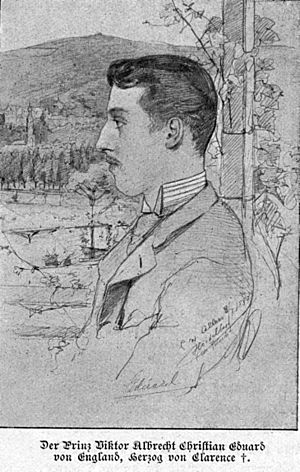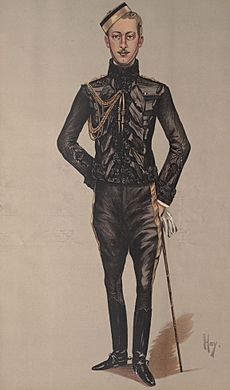Prince Albert Victor, Duke of Clarence and Avondale facts for kids
Quick facts for kids Prince Albert Victor |
|||||
|---|---|---|---|---|---|
| Duke of Clarence and Avondale | |||||
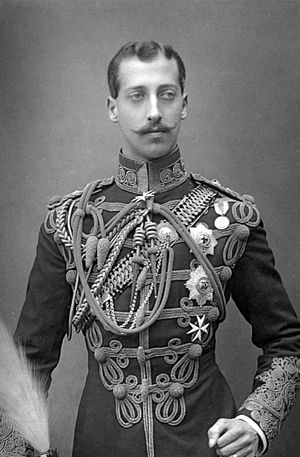
Photograph by W. & D. Downey, 1891
|
|||||
| Born | Prince Albert Victor of Wales 8 January 1864 Frogmore House, Windsor, Berkshire, England |
||||
| Died | 14 January 1892 (aged 28) Sandringham House, Norfolk, England |
||||
| Burial | 20 January 1892 Royal Vault, St George's Chapel, Windsor Castle; later moved to Albert Memorial Chapel, St George's Chapel |
||||
|
|||||
| House | Saxe-Coburg and Gotha | ||||
| Father | Albert Edward, Prince of Wales (later Edward VII) | ||||
| Mother | Alexandra of Denmark | ||||
Prince Albert Victor, Duke of Clarence and Avondale (born Albert Victor Christian Edward; 8 January 1864 – 14 January 1892) was a grandson of Queen Victoria, the ruling British monarch. He was the first child of the Prince and Princess of Wales, who later became King Edward VII and Queen Alexandra.
From the moment he was born, Albert Victor was second in line to the succession to the British throne. However, he never became king or Prince of Wales. This was because he passed away before both his grandmother and his father.
His family and many writers later called Albert Victor "Eddy". When he was young, he traveled a lot as a naval cadet. As an adult, he joined the British Army, but he did not take part in any active military duties. After two attempts to find a wife, he became engaged to Princess Victoria Mary of Teck in late 1891. Just a few weeks later, he died during a big pandemic. Princess Mary later married his younger brother, who became King George V in 1910.
Contents
Early Life

Albert Victor was born early, two months before his due date, on 8 January 1864. This happened at Frogmore House in Windsor, Berkshire. He was the first child of Albert Edward, Prince of Wales, and his wife Alexandra of Denmark.
Following his grandmother Queen Victoria's wishes, he was named Albert Victor. This name honored both the Queen and her late husband, Prince Albert. Because he was a grandchild of the ruling British monarch and a son of the Prince of Wales, he was formally called His Royal Highness Prince Albert Victor of Wales from birth. He was christened Albert Victor Christian Edward on 10 March 1864. This ceremony took place in the private chapel of Buckingham Palace. However, everyone knew him as "Eddy".
Education and Travels
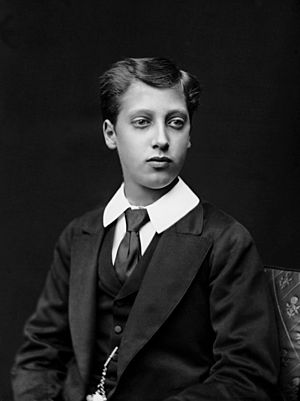
Albert Victor's brother, Prince George of Wales, was born on 3 June 1865. They were close in age, so they were educated together. In 1871, Queen Victoria chose John Neale Dalton to be their teacher. The two princes had a strict study plan. It included games and military training, along with school subjects. Dalton noted that Albert Victor's mind seemed "abnormally dormant," meaning he was slow to learn.
He learned to speak Danish, but he struggled with other languages and subjects. Some thought Albert Victor might have inherited his mother's deafness. He never did very well in school. Some possible reasons for his difficulty learning include absence seizures or his early birth. However, Lady Geraldine Somerset blamed his poor education on Dalton, saying he was not inspiring.
It was thought that the brothers should be educated separately. But Dalton advised against it. He said that Prince Albert Victor needed Prince George's company to make him work. In 1877, both boys were sent to the Royal Navy's training ship, HMS Britannia. They started their studies late because Albert Victor caught typhoid fever. Sir William Gull treated him. Dalton went with them as the ship's chaplain.
In 1879, after much discussion, the royal brothers became naval cadets. They went on a three-year world tour aboard HMS Bacchante. Albert Victor became a midshipman on his sixteenth birthday. They visited many places in the British Empire. These included the Americas, South Africa, Australia, and the Far East. They even got tattoos in Japan. By the time they returned to Britain, Albert Victor was eighteen years old.
The brothers separated in 1883. George stayed in the navy, and Albert Victor went to Trinity College, Cambridge. At Sandringham, Albert Victor was expected to study hard before university. He was with Dalton, a French teacher, and a new tutor, James Kenneth Stephen. Stephen initially felt positive about teaching the prince. But by the time they moved to Cambridge, he thought the prince would not gain much from lectures. He felt Albert Victor "hardly knows the meaning of the words to read".
In October, Albert Victor, Dalton, and Lieutenant Henderson moved to Nevile's Court at Trinity College. This area was usually for teachers, not students. The prince did not show much interest in academics. He was excused from exams, but he did join in student life. He became friends with Oscar Browning, a well-known teacher. He also befriended Dalton's godson, Alfred Fripp, who later became his doctor. In August 1884, he studied German at Heidelberg University. He then returned to Cambridge.
After leaving Cambridge in 1885, he became an officer in the 10th Hussars. In 1888, the university gave him an honorary degree.
One of Albert Victor's teachers said he learned by listening and remembered information well. But Prince George, Duke of Cambridge, had a less positive view. He called him "an inveterate and incurable dawdler." Princess Augusta of Cambridge also had a low opinion, calling him: "si peu de chose" (such a small thing).
Albert Victor spent much time drilling at his post in Aldershot, which he did not like. However, he enjoyed playing polo. He passed his exams. In March 1887, he was moved to Hounslow and promoted to captain. He took on more public duties. He visited Ireland and Gibraltar, and he opened the Hammersmith suspension bridge. A childhood friend later said his private life was calm. His fellow officers wanted him to experience more of the world, but he chose not to.
Tour of India
From October 1889, Albert Victor went on a seven-month tour of British India. This trip had been planned since the spring. He traveled through Athens, Cairo, and Aden. He arrived in Bombay on 9 November 1889. He was grandly welcomed in Hyderabad by the Nizam, and by many other maharajahs elsewhere. In Bangalore, he laid the foundation stone of the Glass House at the Lalbagh Botanical Gardens on 30 November 1889. He spent Christmas in Mandalay and New Year in Calcutta. Most of his travels were by train, but he also rode elephants for ceremonies. As was common at the time, many animals were hunted for sport.
During the trip, Albert Victor met Mrs. Margery Haddon. She was the wife of a civil engineer. After Albert Victor's death, Margery claimed that the Prince was the father of her son, Clarence Haddon. However, there was no proof, and her claims were dismissed. The police Special Branch investigated these claims. Records show that neither the royal staff nor Margery had any evidence to support her story. Albert Victor's lawyers told the police that there had been "some relations" between him and Mrs. Haddon. But they denied he was the father.
In the 1920s, Clarence Haddon repeated the story. He published a book in the United States, My Uncle George V. In it, he claimed he was born in London in September 1890. This was about nine months after Albert Victor met Mrs. Haddon. In 1933, he was accused of trying to get money by threatening the King. At his trial, documents showed that Haddon's birth records and other papers stated he was born in or before 1887. This was at least two years before Albert Victor met Mrs. Haddon. Haddon was found guilty. The judge believed Haddon was suffering from false beliefs. He was not sent to prison but was told not to claim he was Albert Victor's son for three years. Haddon broke these rules and was jailed for a year. His claims were seen as untrue, and he died a sad man. Even if Haddon's claim had been true, it would not have changed the royal line of succession.
When he returned from India, Albert Victor received new titles. He was made Duke of Clarence and Avondale and Earl of Athlone on 24 May 1890. This was Queen Victoria's 71st birthday.
Finding a Bride
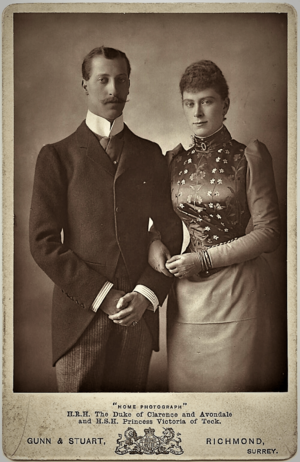
In 1889, Albert Victor's grandmother, Queen Victoria, wanted him to marry his cousin Princess Alix of Hesse and by Rhine. Alix was one of her favorite granddaughters. At Balmoral Castle, he asked Alix to marry him. But she did not feel the same way and said no. He kept trying to convince her, but he finally gave up in 1890. She sent him a letter saying she was sorry to hurt him, but she could not marry him. She liked him as a cousin, but not as a husband. In 1894, Alix married Tsar Nicholas II of Russia, who was also Albert Victor's cousin.
After Alix refused, Queen Victoria suggested another cousin, Princess Margaret of Prussia. On 19 May 1890, the Queen wrote to Albert Victor. She said Margaret would be a good queen. She described Margaret as having a "very pretty figure" and being "very amiable." She also noted Margaret was "half English with great love for England." Albert Victor's father approved. But Queen Victoria's secretary said Albert Victor's mother would strongly object. Nothing came of this suggestion.
By this time, Albert Victor was falling in love with Princess Hélène of Orléans. She was the daughter of Prince Philippe, Count of Paris. He was a claimant to the French throne living in England. At first, Queen Victoria was against the marriage because Hélène was Roman Catholic. But once Albert Victor and Hélène told her they loved each other, the Queen changed her mind. She supported the marriage. Hélène offered to change her religion to the Church of England. Albert Victor offered to give up his right to the throne to marry her.
To their sadness, Hélène's father refused the marriage. He insisted she could not change her religion. Hélène even went to Pope Leo XIII herself to ask for help. But the Pope agreed with her father, and the relationship ended. After Albert Victor died, his sisters Maud and Louise felt sympathy for Hélène. They saw her as his true love, not his fiancée Princess Victoria Mary of Teck. Maud told Hélène that Albert Victor was "buried with your little coin around his neck." Louise said he was "yours in death." Hélène later became Duchess of Aosta.
By 1891, another possible bride was Princess Victoria Mary of Teck. Mary was the daughter of Queen Victoria's first cousin Princess Mary Adelaide, Duchess of Teck. Queen Victoria strongly supported this match. She thought Mary was perfect: charming, sensible, and pretty. On 3 December 1891, Albert Victor proposed to Mary. This happened at Luton Hoo, a country home. Mary was "greatly surprised." Their wedding was planned for 27 February 1892.
Death
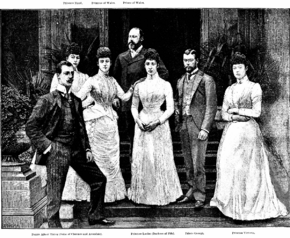
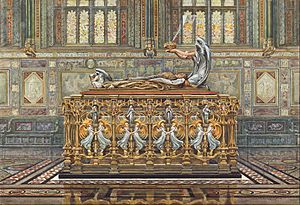
Albert Victor became sick with influenza during the pandemic of 1889–1892. He then developed pneumonia. He died at Sandringham House in Norfolk on 14 January 1892. This was less than a week after his 28th birthday.
His parents, the Prince and Princess of Wales, were present. His sisters Princesses Maud and Victoria, and his brother Prince George, were also there. His fiancée Princess Mary and her parents were present too. Three doctors and three nurses attended him. The Prince of Wales's chaplain read prayers for the dying.
The nation was shocked by his death. Shops closed their doors. The Prince of Wales wrote to Queen Victoria, "Gladly would I have given my life for his." Princess Mary wrote to Queen Victoria about the Princess of Wales. She said, "the despairing look on her face was the most heart-rending thing I have ever seen." His younger brother Prince George wrote, "how deeply I did love him; & I remember with pain nearly every hard word & little quarrel I ever had with him & I long to ask his forgiveness, but, alas, it is too late now!"
George took Albert Victor's place in the line of succession. He eventually became King George V in 1910. Prince George and Mary grew closer during their shared time of sadness. Prince George later married Mary in 1893. She became queen consort when George became king.
Albert Victor's mother, Alexandra, never fully recovered from her son's death. She kept the room where he died as a special memorial. At the funeral, Mary placed her bridal wreath of orange blossoms on his coffin. James Kenneth Stephen, Albert Victor's former tutor, stopped eating after Albert Victor's death. He died 20 days later. He had suffered a head injury in 1886 that caused him mental health problems.
Prince Albert Victor is buried in the Albert Memorial Chapel. This chapel is near St George's Chapel, Windsor Castle. His tomb, made by Alfred Gilbert, is a beautiful example of late 19th-century sculpture. It features a statue of the Prince in a Hussar uniform. An angel kneels over him, holding a heavenly crown. The tomb is surrounded by an ornate railing with figures of saints. Gilbert, a perfectionist, spent too much money on the project. He went bankrupt and left the country. Five smaller figures on the tomb were only finished after he returned to Britain in the 1920s.
Legacy
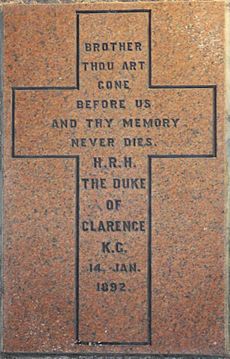
During his lifetime, most British newspapers spoke of Albert Victor with respect. The tributes after his death were full of praise. The politician Henry Broadhurst, who met both Albert Victor and his brother George, said they were humble and not proud. On the day Albert Victor died, the politician William Ewart Gladstone wrote in his diary that it was "a great loss."
In the mid-20th century, some biographers described Albert Victor negatively. They said he was lazy, not well-educated, and physically weak. However, other writers have tried to show Albert Victor in a more positive way. They argue that his slow progress in school was partly due to his tutor's teaching style. They also say he was a warm and charming person. Some historians believe his reputation was made worse by writers who wanted to make his brother, George, look better.
Fictional Portrayals
Stories and theories about Albert Victor have led to him being shown in films. For example, in the 1979 Sherlock Holmes movie Murder by Decree, he is called "Duke of Clarence (Eddy)". In the 1988 TV series Jack the Ripper, Marc Culwick played Prince Albert Victor. Samuel West played "Prince Eddy" in The Ripper (1997). He had also played Albert Victor as a child in the 1975 TV mini-series Edward the Seventh.
Older versions of Albert Victor in Edward the Seventh were played by Jerome Watts and Charles Dance. From 1989 to 1998, Alan Moore and Eddie Campbell published the graphic novel From Hell. This story was made into a 2001 film by the Hughes brothers. Mark Dexter played both "Prince Edward" and "Albert Sickert" in the film. This story is also the basis for a play called Force and Hypocrisy.
In some alternative history novels, Albert Victor survives and becomes king. For example, in Peter Dickinson's King and Joker (1976) and Skeleton in Waiting (1990), he reigns as King Victor I. In Gary Lovisi's Sherlock Holmes: The Hidden Years, Albert Victor is a powerful king. The Prince also appears as a murder victim in the novel Goodnight Sweet Prince. He is also a murder suspect in Death at Glamis Castle.
In some fantasy novels, he becomes a vampire. These include The Bloody Red Baron by Kim Newman and I, Vampire by Michael Romkey. In The Bloody Red Baron, he is the British monarch during the First World War. The Prince of Mirrors by Alan Robert Clark is a historical novel that follows Albert Victor's real life. It also imagines his emotional experiences. Two DC Comics series, Gotham by Gaslight and Wonder Woman: Amazonia, also feature Prince Albert ("Eddy") as a small character.
Titles, Styles, Honours and Arms
Titles and Styles
- 8 January 1864 – 24 May 1890: His Royal Highness Prince Albert Victor of Wales
- 24 May 1890 – 14 January 1892: His Royal Highness The Duke of Clarence and Avondale
The Duke of Clarence's full title, announced at his funeral, was: "Most High, Mighty, and Illustrious Prince Albert Victor Christian Edward, Duke of Clarence and Avondale, Earl of Athlone, Duke of Saxony, Prince of Saxe-Coburg and Gotha, Knight of the Most Noble Order of the Garter, Knight of the Most Illustrious Order of Saint Patrick".
Honours
British Honours
- KG: Royal Knight of the Most Noble Order of the Garter, 3 September 1883
- KP: Extra Knight of the Most Illustrious Order of Saint Patrick, 28 June 1887
- ADC: Personal Aide-de-Camp to the Queen, 21 June 1887
- LLD: Doctor of Laws, University of Dublin, 1887
- LLD: Doctor of Laws, University of Cambridge, 1888
- Sub-Prior of the Venerable Order of Saint John of Jerusalem, 1888
Foreign Honours
 Grand Cross of the Order of the Netherlands Lion
Grand Cross of the Order of the Netherlands Lion Grand Cross of the Royal Military Order of the Tower and Sword, 5 March 1885
Grand Cross of the Royal Military Order of the Tower and Sword, 5 March 1885 Grand Cross of the Royal and Distinguished Order of Charles III, with Collar, 23 January 1885
Grand Cross of the Royal and Distinguished Order of Charles III, with Collar, 23 January 1885 Order of Osmanieh, 1st Class in Diamonds
Order of Osmanieh, 1st Class in Diamonds Grand Cross of the Order of the Star of Romania
Grand Cross of the Order of the Star of Romania Knight of the Supreme Order of the Most Holy Annunciation, 8 January 1885
Knight of the Supreme Order of the Most Holy Annunciation, 8 January 1885 Grand Cross of the Order of the Southern Cross
Grand Cross of the Order of the Southern Cross

 Grand Cross of the Saxe-Ernestine House Order, 1883
Grand Cross of the Saxe-Ernestine House Order, 1883 Grand Cross of the Grand Ducal Hessian Order of Ludwig, 30 April 1884
Grand Cross of the Grand Ducal Hessian Order of Ludwig, 30 April 1884 Grand Cross of the Order of the White Falcon, 1885
Grand Cross of the Order of the White Falcon, 1885 Knight of the Order of the Elephant, 11 October 1883
Knight of the Order of the Elephant, 11 October 1883
 Knight of the Royal Order of the Seraphim, 8 January 1885
Knight of the Royal Order of the Seraphim, 8 January 1885 Knight of the Order of the Black Eagle, 8 January 1885
Knight of the Order of the Black Eagle, 8 January 1885 Grand Cordon of the Order of Leopold, 1885
Grand Cordon of the Order of Leopold, 1885
 Grand Cross of the Royal Hungarian Order of Saint Stephen, 1887
Grand Cross of the Royal Hungarian Order of Saint Stephen, 1887
Military Ranks
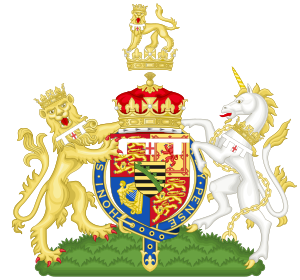
- 1877–1879: Cadet aboard training ship HMS Britannia, Dartmouth, Devon
- 1879–1880: Cadet, HMS Bacchante
- Mid, 1880–1883: Promoted to Midshipman, HMS Bacchante
- Lt, 1886–1887: Appointed Lieutenant, 10th (Prince of Wales' Own) Royal Hussars
- Capt, 1887: Promoted to Captain, 9th Queen's Royal Lancers
- Capt, 1887–1889: Captain, 3rd King's Royal Rifle Corps
- Maj, 1889–1892: Major, 10th (Prince of Wales' Own) Royal Hussars
Honorary Military Appointments
British
 Honorary Colonel, 4th Regiment, Bengal Infantry
Honorary Colonel, 4th Regiment, Bengal Infantry Honorary Colonel, 4th Bombay Cavalry
Honorary Colonel, 4th Bombay Cavalry Honorary Colonel, 1st Punjab Cavalry
Honorary Colonel, 1st Punjab Cavalry- Honorary Colonel, Third City of London Rifle Volunteer Corps (7th (City of London) Battalion, London Regiment) 1890–92
Arms
When he became a duke, Albert Victor was given a coat of arms. It was based on the royal arms of the United Kingdom. It had a small shield showing the arms of Saxony. It also had a label with three white points, and the middle point had a red cross.
See also
 In Spanish: Alberto Víctor de Clarence para niños
In Spanish: Alberto Víctor de Clarence para niños


